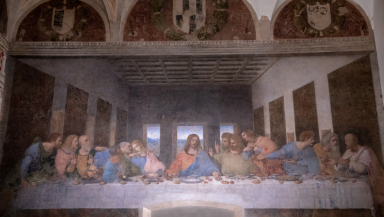
Leonardo da Vinci's 'The Last Supper', created between 1495 and 1498, remains one of the most profound and influential Christian-themed artworks in history. Commissioned by Duke Ludovico Sforza of Milan for the refectory of the Convent of Santa Maria delle Grazie, this fresco depicts the pivotal moment when Jesus announces that one of His disciples will betray Him, a revelation that sets the stage for His impending crucifixion.
This painting transcends mere artistic representation; it vividly captures the emotional and spiritual turmoil of the apostles, each figure rendered with remarkable psychological depth.
Imagine how groundbreaking it would have been when first viewed by Christian believers who had never before witnessed images of the people, places, or scenes described in the Bible. Such a vision of God would have been considered a blessing, and a painting like this had the power to illustrate the divine.
Leonardo's masterful use of perspective and composition not only draws viewers into the scene but also emphasises the gravity of the moment. The varied expressions and reactions of the apostles bring to life their shock and disbelief, showcasing Leonardo's unique ability to convey complex human emotions. Expressive, almost theatrical, body language is used to dramatise the moment on the canvas. It is almost as if too much is happening at once, and the eye is forced to digest small segments of detail and then piece these together into a fluid narrative.
Judas Iscariot, the disciple who betrays Jesus, is positioned among the apostles but is distinctively set apart through da Vinci's composition. He is depicted reaching towards a dish, echoing Jesus's statement that the betrayer would share the dish with Him. Judas is also placed in shadow, contrasting with the more illuminated figures of the other apostles. This positioning and the darker hues used for Judas symbolise his inner turmoil and foreshadow his impending betrayal, highlighting his moral conflict and separation from the others.
The layers of meaning in 'The Last Supper' have intrigued scholars and theologians for centuries. While some interpretations suggest hidden messages or esoteric symbols, many of these theories remain speculative. The arrangement of the figures, their gestures, and the interplay of light and shadow may indeed offer deeper insights into da Vinci's religious and philosophical reflections. However, these interpretations often reflect a broader quest to understand Leonardo's spiritual and intellectual world rather than definitive answers.
Today, 'The Last Supper' is housed in the Convent of Santa Maria delle Grazie in Milan. Due to its fragile condition and the importance of preserving this masterpiece, public access is carefully controlled. Visitors must secure tickets in advance to view the painting, as the number of visitors is limited to protect the artwork from deterioration.
Monetarily valuing 'The Last Supper' is a daunting task; its significance extends far beyond financial worth. Its true value lies in its cultural and historical impact, which cannot be quantified. The fresco is celebrated not only for its artistic excellence but also for its enduring influence on art, culture, and religious reflection.
Whether 'The Last Supper' is Leonardo's greatest work is a matter of opinion. While many consider it his crowning achievement due to its innovative perspective and emotional depth, other masterpieces, such as the 'Mona Lisa', also vie for this title. This diversity in Leonardo's output reflects his extraordinary artistic range, easily moving between secular, religious, and even scientific expressions.
Leonardo da Vinci's religious views were complex, intertwining with his broader intellectual pursuits. His engagement with Christian themes was significant, yet his work often transcended traditional interpretations, blending spiritual inquiry with philosophical exploration. This nuanced approach imbues his art with a timeless quality, offering both inspiration and reflection to audiences across generations.
Rightfully, 'The Last Supper' is considered a masterpiece that endures as a study of the human condition and of Christianity itself, inviting viewers to ponder the depths of faith, betrayal, and the necessity of divine sacrifice.













